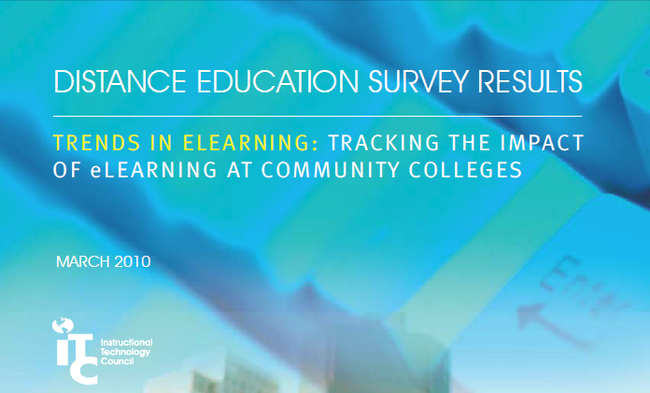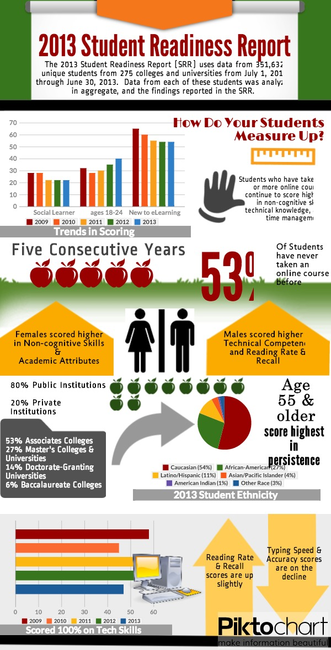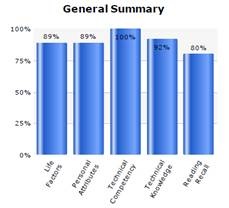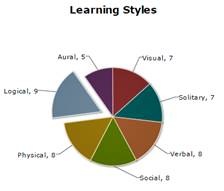Get a “SMART” Start - Tools to Help Students Succeed Online
Introduction
Research shows that maintaining high retention rates in distance learning education is a challenge. There are various tools and resources available web-based tools that can help identify at-risk students and measure and boost opportunities for growth and success. Students can take advantage of these resources to prepare ahead of time to ensure a "SMART" start and successful commpletion of their online course work.
First we will review SmarterMeasure to identify attributes, skills and knowledge and assess competencies necessary for successful distance learning and help identify potential resources to help maximize efficiency in potentially deficient areas.
Then we will review SMARThinking that helps educational institutions offer students outstanding academic support through a network of professionally certified educators focused on increasing student achievement and enhance learning.

San Antonio Student is frustrated working in her online course at the computer.
Objectives
- Discuss current Research regarding retention rates in distance learning.
- Illustrate two web-based tools that can help identify at-risk students and measure opportunities for growth.
- Examine SmarterMeasure to identify competencies necessary for successful distance learning.
- Analyze SMARThinking as a focus on increasing student achievement and enhance learning.
Research
ITC Distance Education Survey Results
eLearning Survey Results

Image of the 2010 ITC Distance Learning Survey Results Report regarding Trends in Learning: Tracking the Impact of Learning at Community Colleges - March 2010
Campuses reported an 22 percent increase for distance learning enrollments, while Sloan-C reports increases in overall campus enrollments averaged less than two percent.
Distance education administrators continue to address the need for course quality and design, faculty training and preparation, course assessment, and improving student readiness and retention. Programs are challenged by a lack the staff and resources to be successful.
The
completion rate gap between distance learning and face-to-face student has
significantly narrowed. Completion rates jumped to a reported 72 percent, just
below the 76 rate for face-to-face classes.
Fred
Lokken,
associate dean for the Truckee Meadows Community College WebCollege,
authored the study based on a survey of 226 community colleges.
SmarterMeasure
SmarterMeasure’s mission is to organize and analyze data that empowers people to make smarter decisions. Use the SmarterMeasure tool to see if distance learning is a good fit for you. SmarterMeasure is a web-based tool which assesses your likelihood for succeeding in an online learning program. SmarterMeasure indicates the degree to which you possess attributes, skills and knowledge that contribute to success in online learning. SmarterMeasure takes about 35 minutes to complete and measure strengths and opportunities for growth in the following five major assessment components:
- Individual Attributes –time management, academic attributes, procrastination, willingness to ask for help
- Learning Styles – what is your predominant learning style?
- Technical Competency, Skills, and Knowledge
- Reading Rate and Recall
- Typing Speed and Accuracy
- Life Factors
SmarterMeasure serves as an early warning device to identify students who may be deficient in the skills and attributes necessary for successful distance learning and who may, therefore, be at risk of dropping out of distance education programs.
When you finish taking the assessment, you will be provided with a detailed, individualized report that will provide you with easy to interpret results based on your input and will provide links to potential resources to help you maximize efficiency in any potentially deficient areas.
Integrated Features

The 2013 Student Rediness Report (SSR) uses data from 351, 632 unique students from 275 colleges and university form July 1, 201 through June 30, 2013. Data from each of the4se students was analyzed in an aggregate, and the findings reported in the SSR.
Score Report and Guide to Interpretations - Immediately upon completion of SmarterMeasure students are provided a score report and a guide to interpreting the scores. Scores for each of the five constructs measured by SmarterMeasure are presented through color-coded graphics and explanatory text. Students are provided their composite scores through a color-coded chart ranking their performance on a four-point scale of opportunity for improvement through strength. The student's individual SmarterMeasure scores are compared to the national averages through a color-coded scatter plot. SmarterMeasure scores are presented through visually appealing graphics resembling speedometers, radars, and dart boards. Explanatory text is provided for each item scored in SmarterMeasure. The report is concluded with over thirty links to additional resources for remediation and support.
Reporting - Each student who takes SmarterMeasure receives immediate feedback in the form of an individualized report that shows his/her score for each of the various SmarterMeasure components. The scores are presented in textual and graphical formats. Licensed institutions receive a summative report detailing overall usage, as well as the individual SmarterMeasure scores of their students. View a sample report.
Solutions - If the instrument determines that a user is not ready to study at a distance, links to potential remediation resources are provided. At this point the participating institution may also provide additional resources.
Ease of Interpretation - Results are presented in easy-to-interpret charts and graphs instead of confusing columns of numbers and figures. The on-screen report consists of colorful charts that indicate the participant's level of READIness in reading rate & comprehension, technical competency, individual attributes, typing speed & accuracy, and preferred learning styles.

General Summary bar chart for Student X showing that the student has scored the following: 89% Life Factors, 89% Life Attributes, 100% Technical Competency, 92% Technical Knowledge and 80% Reading Recall.
Individual attributes
Personal Information are collects demographic information such as name, email address, age range, gender and the number of online courses the person has taken, etc.
Personal Attributes area measures traits, habits and attitudes that impact one’s goodness of fit of distance education as a delivery system. The six attributes which are measured are time management, procrastination, persistence, academic attributes, locus of control, and willingness to ask for help. There are 24 items in this section with each of the six attributes being measured.

Pie Chart for Student X representing Learning Styles: Aural = 5, Solitary = 7, Verbal = 8, Social = 8, Physical = 8, Logical = 9
Learning Styles
This portion of the survey measures the preferred learning styles of the student. The learning styles inventory is based on the multiple intelligences model which measures the following seven learning styles: visual, verbal, social, solitary, physical, logical, and aural. There are 35 items in this section with each of the seven learning styles being measured.
Technical Competency
The Technical portion measures the degree to which the participant possesses knowledge of items related to instructional technology. In this section there are seven technology usage items which measure the degree to which the participant uses specified instructional technologies. The technology in your life section contains two items through which the participant indicates the level at which they integrate technology into other areas of their life. The technology vocabulary section contains ten items.The personal computer / Internet specification section contains four items and allows the student to report facts about the primary computer and Internet connection which they will be using to participate in online courses.
Reading Rate and Recall
This area consists of passages which are selected by the institution based on the appropriate Flesh-Kincaid Grade Level for the participants. The section begins with an instruction screen which informs the student that they are about to read a passage and then be quizzed on their comprehension of the passage. Participants are notified that they will not be able to view the passage during the assessment and that their reading is being timed. The On-screen Reading Rate and Recall assessment contains eleven items which are each measured by a multiple-choice item containing three choices.
Version 6.0 of SmarterMeasure (Released January, 2009) contains multiple reading passages at grade levels 8 through 12. Comprehension of these passages is measured by ten items which based on the following five categories of comprehension: sequencing, factual information, inferential information, cloze process and the main idea of the passage.
Typing Speed and Acuracy
This segment provides a skills test through which the student demonstrates their typing skills. Participants are first allowed to select the orientation of the sample passage to be typed in relation to the typing input window. Students then type the text. The score report visually presents their errors and typing rate.

Graphic for Student X representing Typing Accuracy and Speed: Typing Accuracy = 100%; Typing Speed = 40 Words Per Minute
Resources
http://www.smartermeasure.com/research/research-results/
SMARThinking
SMARTHINKING's fundamental objectives are to engage and encourage students in active learning, as well as to enhance their motivation. Our tutors strive to help students develop successful learning skills, rather than simply "giving answers" or "doing homework" for them. In a professional and supportive environment, we focus on the power of human interaction and the use of technology to assist a student-centered tutoring process.
- Objective: Engage students in active learning and enhance motivation
- Increase student achievement
- Virtual Learning Assistance Center
- Access to E-structor® Certified tutors 24/7
- Over 800 professionals and educators
- Provides people, technology and training
- Help educational institutions offer their students outstanding academic support
- Develop custom solutions to better support their faculty
Services
- Live, Online Tutoring
- Online Writing Lab
- Essay Grading Assistance for Writing
- Custom Academic Support Programs
- Hosted Virtual Learning Center Technology
- Support for ESL Students
- Support for Nursing and Allied Health Students
Live, Online Tutoring
Live, Online Tutoring provides online tutoring in Mathematics, Writing, General Chemistry, Organic Chemistry, Physics, Biology, Introduction to Human Anatomy and Physiology, Accounting, Economics, Introductory Finance, Spanish, Statistics, Nursing and Allied Health and more. Online Math tutors are available 24 hours a day, seven days a week during the school year. Over 90% of SMARTHINKING online tutors have a Masters or PhD in their respective discipline, and they average nine years of teaching experience. Students can:
"Drop-in" for live tutoring
Tutors will:
- Encourage students with constructive criticism;
- Help students identify areas for improvement;
- Involve students in discussion and problem-solving strategies;
- Treat students with respect.
Tutors will not:
- Do assignments for the learner, give answers or write any portion of papers;
- Review and correct errors without active participation of the learners;
- Comment on grades or predict a possible grade.
Online Writing Lab
Staffed with professional online writing tutors, SMARTHINKING’s Online Writing Lab helps students at secondary, post-secondary, and graduate levels become stronger writers. Students receive a detailed, personalized critique of any written assignment, such as an essay, report, personal statement, cover letter, resume, or creative story. Students may choose a 30-minute review or a 60-minute review for longer essays.
Students can also receive a detailed critique of their practice SAT essay. The critique identifies an essay's strengths, notes its weaknesses, and provides a sample score. Students can submit writing 24 hours a day, seven days a week during the academic year.
Submit questions for a response within 24 hours; Pre-schedule sessions; and View archives of past sessions.
Essay Grading Assistance for Writing
Research shows students improve as writers when they write frequently and receive helpful, timely feedback and assessment. With SMARTHINKING's GradeGuidance program, SMARTHINKING E-structor® Certified tutors -- 90% of whom have a masters degree or PhD in a writing related discipline -- provide a suggested grade and individualized comments that identify strengths and areas for improvement in a student's writing. From the Internet, a professor can view all of his or her students' submitted papers, responses from SMARTHINKING tutors,and suggested grades. The professor maintains ultimate grading authority.
SMARTHINKING tutors -- like teaching assistants -- merely shoulder the commenting and assessment burden. With increased feedback that supports the professor's in-class and on-paper comments, students get more writing assistance and practice. Students promptly receive a suggested grade that will be consistent across a school's sections and classes. Further, by having a third party assess a paper, grading disputes between student and instructor can be minimized.
Custom Academic Support Programs
SMARTHINKING will develop and staff a custom academic support program for any school or company. The client chooses the subject(s) to be tutored, the number of staffed E-structor® Certified tutors, the hours when online tutors are available, the language to be spoken in tutorials (i.e. English, Spanish), and the curriculum to follow; and SMARTHINKING will build the program. SMARTHINKING has developed programs for Houghton Mifflin College Publishing, Lippincott, Williams & Wilkins Publishing, Texas Instruments, Massachusetts Department of Education, Texas TRACK Plus program, Los Angeles Independent School District, Clark County (Nevada), and many others.
Hosted Virtual Learning Center Technology
Should a school want to staff its own online tutoring center, SMARTHINKING can be the technology provider. SMARTHINKING licenses its technology platform to clients and provides training and consulting on the delivery of online tutoring programs. Also, a school can combine its tutors with SMARTHINKING's E-structor® Certified tutors to create a comprehensive online tutoring infrastructure.
Support for ESL Students
ESL students can submit essays to
SMARTHINKING’s online writing lab and receive a critique from an ESL writing
specialist.
Students for whom Spanish is their first language can receive drop-in math tutoring from bilingual E-structor® Certified tutors.
Support for Nursing and Allied Health Student
SMARTHINKING’s live, online tutoring gives students access to expert nursing educators whose mission is to help students achieve success. Using a proprietary tutoring method, as well as a sophisticated online whiteboard, SMARTHINKING’s nursing tutors help students master complex nursing/medical issues while developing critical thinking skills.
Students can get help with a troublesome homework assignment or even with NCLEX test prep. With SMARTHINKING, students go to class or to a test—prepared.
Resources
Conclusion
BE "SMART"
When students utilize tools that provide meaningful preparatory and engaging activities, they become eempowered to work smarter and not harder.
- Survey the Students at the Start
- Monitor and Measure success and retention
- Awareness and Action regarding potential deficiencies
- Remediate early based on Real Results and Resources
- Take Advantage of Tools for Distance Learning
- SmarterMeasure, formerly known as READI
- SMARThinking (online tutoring)

San Antonio College student is happy working on her online course at her computer.